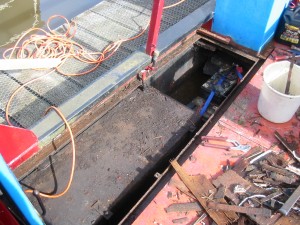It feels odd being in the house without Kathy, I know I spend a lot of time during the day by myself normally but its in the evenings that I really miss her. It seems odd cooking just for me and the evenings drag on and when it comes to bed time it really does hit home.
But I’m not the only one missing her. Most of the cats, like Chester and Munchkin, don’t really seem to be bothered, and Chester only really gets bothered when we’ve got the suitcases out and mum and dad turn up because he knows something is going on. But Bandit really is missing her.
Bandit was a cat we didn’t plan on having. When we went to get Pixie, who is a black cat, Bandit was the only kitten left from the litter who hadn’t been adopted and he was the runt of the litter and so we took him home along with Pixie.
Here is a photo of him taken as soon as we got him home back in August 2006 (the fuzzy black in the background is Pixie) :
Bandit, along with Pixie, is a quite photogenic and when he was settling in here he just gave us a lot of photo opportunities:
Those being just two from a large collection of “cute” photos.
As Bandit grew (and boy did he grow) he really bonded with Kathy and sometimes he seems to behave more like a dog in that he followed Kathy round the house and he loved carrying things round in his mouth too. In the evenings after supper he often hopped up into Kathy’s lap to get some attention and he “patty paws” her. Bandit is really Kathy’s cat and he never grew out of the habits he showed as a kitten.
He’s now three and is a big solid cat as can be seen from this recent picture where he is relaxing on the doormats we brought back from the boat for cleaning (the ears in the foreground are Pixie’s)
He might be a big solid cat but he’s really missing Kathy and when I go to bed at night he hops up on top of me and miaows and demands lots of attention. If I ignore him then he headbutts my hand or my arm until I give him tickles. If I put my arms under the covers then he lies on me and stretches out his left paw and pats me on the chin, and if I ignore that then he resorts to licking the end of my nose. Then when he’s had enough tickles he goes to the bottom of the bed and goes to sleep down there. When Kathy is home he tends to sleep on her side of the bed.
Now I know that you’ll probably just say that its a cat and he doesn’t care where he gets his tickles from but its only in the early evening that his behaviour changes. During the day he’s doing just what he does most days, sleeping on our bed or out in the utility room on the boat mats. Its when it gets to about 6:30 which is when Kathy usually home that he starts prowling round the house more and he miaows a lot more too.
Both Kathy and I know what he’ll be like when she gets home, she wont be able to go anywhere in the house for days without him sticking to her like glue and any time she sits down he’ll be there in her lap demanding attention.










